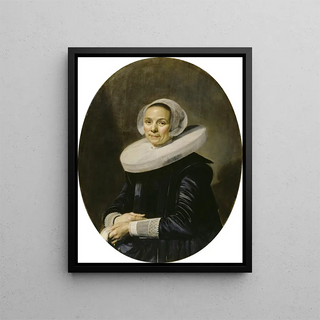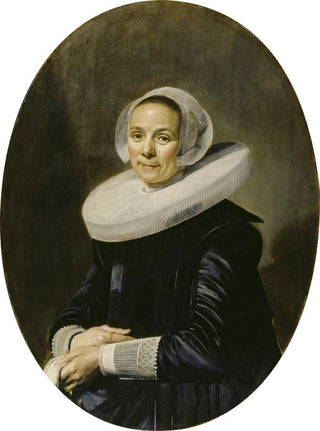Painting Portrait of a Woman - Frans Hals | Art print


View from behind

Frame (optional)
Portrait of a Woman - Frans Hals – Captivating Introduction
In the fascinating world of 17th-century painting, Frans Hals's "Portrait of a Woman" stands out for its brilliance and emotional depth. This artwork, emblematic of Dutch Baroque style, transports us to a time when art was not only a means of expression but also a reflection of societal morals and values. Gazing at this portrait, the viewer is immediately struck by the vibrancy of the colors and the artist's technical mastery. The woman's gaze, both gentle and penetrating, seems to tell a story, inviting each viewer to ponder her identity and status. The art print of this masterpiece allows appreciation of the richness of this work while making it accessible to a broader audience.
Style and uniqueness of the work
Frans Hals's style is renowned for its realistic approach and bold use of light and shadow. In the "Portrait of a Woman," the artist manages to capture not only her physical features but also her very essence. The fluidity of the brushstrokes, typical of Hals, gives a particular dynamism to the piece. Every detail, from the drapes of the dress to the reflections in the hair, is treated with meticulous attention, demonstrating rare virtuosity. This portrait also stands out for its psychological approach, where the facial expression and posture of the woman suggest a depth of character. Thus, this work does not merely depict a figure; it evokes a personality, a story, a life.
The artist and his influence
Frans Hals, born in Antwerp in 1582, is one of the undisputed masters of Dutch painting. His career, spanning several decades, is marked by constant innovation and an ability to capture the spirit of his time. Hals succeeded in establishing himself through his unique technique and his capacity to portray subjects with rare emotional intensity. His influence on subsequent generations of artists is undeniable, inspiring major figures such as Rembrandt and Vermeer. By incorporating elements of spontaneity and liveliness into his portraits, Hals paved the way for a new way of perceiving the human subject.

Matte finish

View from behind

Frame (optional)
Portrait of a Woman - Frans Hals – Captivating Introduction
In the fascinating world of 17th-century painting, Frans Hals's "Portrait of a Woman" stands out for its brilliance and emotional depth. This artwork, emblematic of Dutch Baroque style, transports us to a time when art was not only a means of expression but also a reflection of societal morals and values. Gazing at this portrait, the viewer is immediately struck by the vibrancy of the colors and the artist's technical mastery. The woman's gaze, both gentle and penetrating, seems to tell a story, inviting each viewer to ponder her identity and status. The art print of this masterpiece allows appreciation of the richness of this work while making it accessible to a broader audience.
Style and uniqueness of the work
Frans Hals's style is renowned for its realistic approach and bold use of light and shadow. In the "Portrait of a Woman," the artist manages to capture not only her physical features but also her very essence. The fluidity of the brushstrokes, typical of Hals, gives a particular dynamism to the piece. Every detail, from the drapes of the dress to the reflections in the hair, is treated with meticulous attention, demonstrating rare virtuosity. This portrait also stands out for its psychological approach, where the facial expression and posture of the woman suggest a depth of character. Thus, this work does not merely depict a figure; it evokes a personality, a story, a life.
The artist and his influence
Frans Hals, born in Antwerp in 1582, is one of the undisputed masters of Dutch painting. His career, spanning several decades, is marked by constant innovation and an ability to capture the spirit of his time. Hals succeeded in establishing himself through his unique technique and his capacity to portray subjects with rare emotional intensity. His influence on subsequent generations of artists is undeniable, inspiring major figures such as Rembrandt and Vermeer. By incorporating elements of spontaneity and liveliness into his portraits, Hals paved the way for a new way of perceiving the human subject.
12,34 €






